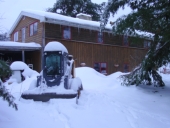I would like to tinker with rocket stoves, without the fire.

In otherwords, experiment with various notions without have the light up a fire, or require testing parts be fireproof, or keep at a distance for observations and measurements.
For example - I'd like to test out a venturie to recirculate some smoke for a reburn. Without fire, I can make test shapes with paper and plastic pipe, and stick my head right in the pipe to see how it's working
if I can avoid the fire part of the rocket stove but still have the draft effect.
So far, I've gotten an infinitely variable-speed leaf blower which I want to blow into the wood feed. What I'm trying to do now is figure our what speed best approximates the normal draft of the rocket stove while burning.
I figure I need to run and typical fire and measure the flow - probably at the top of the stack (simple cooker design - no bench). Then match that measurement by playing with the blower speed switch.
Problem is, how to get first measurement in the fire?... any ideas?








